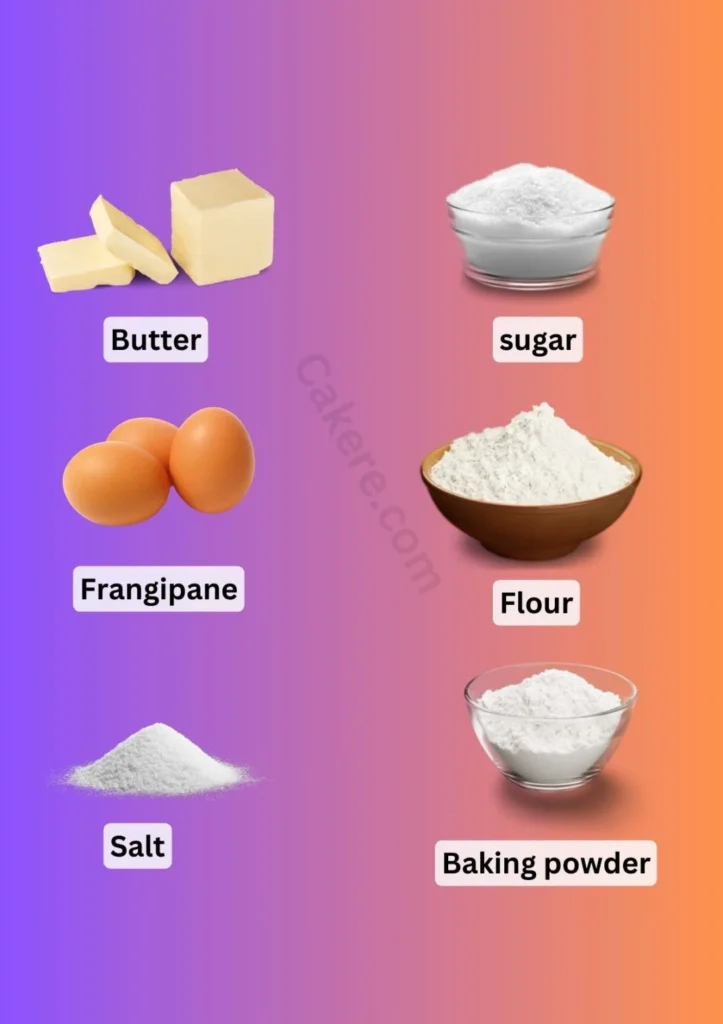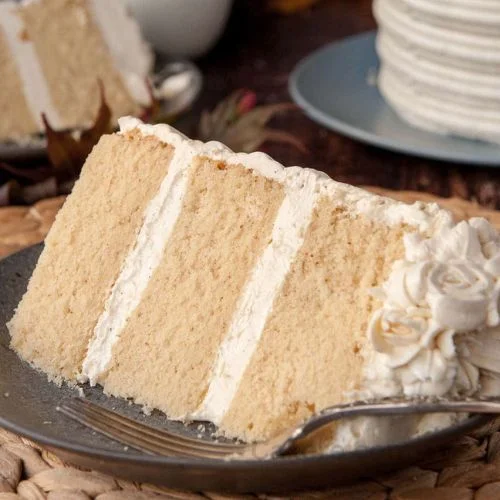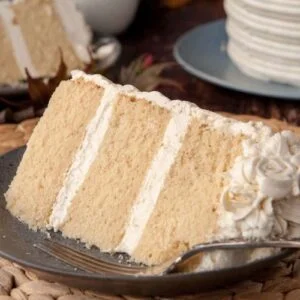The Brown Butter Cake Recipe is a popular and delightful dessert. Made with browned butter, it offers a warm, nutty flavor, ideal for autumn. This cake’s light and fluffy texture allows for creative pairings with various frostings and fillings, resulting in a unique and delicious dessert.
Key Brown Butter Cake Ingredients & Why

Butter
Brown butter cake’s distinct flavor comes from browning the butter until it’s nutty and caramel-like.
Sugar
Brown sugar complements the nutty notes of browned butter in these recipes, and some may use granulated sugar.
Flour
Brown butter cake recipes typically call for all-purpose or cake flour.
Eggs
Eggs are a staple in most cake recipes, including brown butter cake.
Baking Powder
It’s used to make the cake rise and become light and fluffy.
Salt
A touch of salt is often added to enhance the cake’s flavor.

How Do You Make The Best Brown Butter Cake?
- Ensure room-temperature ingredients and use a scale to measure. Substituting may lead to recipe failure. (Refer to notes below)
- Preheat oven to 335º F and prep three 6″x2″ cake pans (or two 8″x6″ pans) with cake goop or preferred release agent.
- Measure 4 ounces of buttermilk in a separate container, add vegetable oil, and set aside. (Adjust for recipe doubling or tripling)
- Combine remaining buttermilk, vanilla, and eggs. Gently whisk and set aside.
- Place flour, sugar, brown sugar, baking soda, baking powder, and salt in the stand mixer bowl with the paddle attachment.
- Start the mixer at the lowest speed (Setting 1 on Kitchen Aid mixers) and add browned butter to the flour mixture. Mix until batter resembles coarse sand.
- Incorporate buttermilk and oil into the flour mixture.
- Increase mixing speed to medium (Setting 4 on Kitchen Aid mixer) and mix for 2 minutes until it thickens and lightens in color. It should resemble soft-serve ice cream. Proper mixing is crucial for rising cakes.
- Scrape the bowl; it’s essential. Skipping this step may result in lumps of flour and unmixed ingredients in your batter.
- Add the egg mixture in three parts, allowing 5-10 seconds between additions. Scrape the bowl midway.
- If your batter appears curdled or broken, it may be due to cold milk/eggs, potentially affecting the cake’s rise.
- Divide the cake batter among your pans. I recommend weighing to ensure even distribution.
- Bake for at least 30 minutes before testing for doneness. Larger pans require longer baking. For pans over 12″, consider using a baking core. Cakes are ready when a toothpick comes out clean or the tops spring back when lightly touched.
- After cooling for 10 minutes or when pans are safe to touch, flip cakes onto cooling racks to cool completely. Wrap in plastic or chill in the refrigerator or freezer for an hour to speed up cooling. Frost and decorate as desired
Pro Tips For Making Brown Butter Cake Recipe
- To maximize flavor, don’t stop browning until you’ve toasted all milk solids. Avoid stopping too early when you see brown bits; it leads to less flavor and more ‘oil’ in the batter/cake.
- Opt for large eggs, cake flour, and full-fat sour cream or vanilla Greek yogurt for a tender, fine crumb. In the absence of cake flour, use all-purpose flour with a two-tablespoon cornstarch swap.
- Store the cake in the refrigerator but allow it to warm up for a few hours before serving to prevent it from turning dry and crumbly due to cold butter.
- Brown butter complements other flavors; feel free to experiment with different cake layers and buttercream combinations.
- Ensure even baking by using damp baking strips on your pans.
- After browning, thoroughly chill the butter before re-softening to avoid issues with batter aeration and cake sinking.
How to Store Brown Butter Cake
- Let the cake cool completely before storing.
- Preserve freshness by wrapping the cake in plastic or using an airtight container.
- Refrigerate the cake for 3-6 days.
- Frosted cakes should be refrigerated.
- To store brown butter, refrigerate it for up to a month after it cools, using an airtight container, plastic wrap, or foil.
Can You Freeze Brown Butter Cake?
Freeze brown butter cake for a month by wrapping it tightly in plastic wrap and aluminum foil. You can also freeze leftover buttercream for up to 2 months. Cake layers and gooey butter cake are freezer-friendly too – just wrap them in plastic or use a large freezer bag. To enjoy your cake, allow it to thaw at room temperature after taking it out of the freezer.
Frequently Asked Questions About Brown Butter Cake
How do I make brown butter for the cake?
Transforming regular butter into brown butter is a delightful process. Simply melt it in a pan over low to medium heat until it achieves a deep, golden hue and releases a delightful nutty fragrance. Exercise caution to prevent overcooking. Once the butter attains its rich, caramelized state, allow it to cool before incorporating it into your cake recipe.
What does brown butter add to the cake?
Elevate your cake’s taste with the complexity of brown butter, boasting hints of caramel and nuttiness. Plus, experience a more indulgent texture.
Can I use regular butter instead of brown butter?
For the finest results, choose brown butter to enhance this cake’s unique flavor.
What types of cakes can I make with brown butter?
Brown butter opens up possibilities for a wide range of cake creations, from pound cakes to layer cakes, sheet cakes, and even cupcakes. It seamlessly integrates into numerous cake recipes.

Brown Butter Cake Recipe
Ingredients
Equipment
Ingredients
- 14 ounces cake flour
- 8 ounces granulated sugar
- 4 ounces brown sugar sifted
- 1 teaspoon baking soda
- 1 teaspoon baking powder
- 1 teaspoon salt
- 1 Tablespoon vanilla extract
- 10 ounces buttermilk warmed, and divided
- 3 large eggs room temperature
- 8 ounces browned butter room temperature
- 4 ounces oil
Instructions
- Ensure all ingredients are at room temperature and use a scale for precision. Substituting ingredients can lead to recipe failure (see notes below).
- Preheat the oven to 335º F and prep three 6"x2" cake pans (or two 8"x6" pans) with cake goop or your preferred pan release.
- Measure 4 ounces of buttermilk, add vegetable oil, and set aside. Adjust this amount if you're doubling or tripling the recipe.
- Combine the remaining buttermilk with vanilla and eggs, whisk lightly, and set aside.
- Place flour, sugar, brown sugar, baking soda, baking powder, and salt in the stand mixer bowl with the paddle attachment.
- Start the mixer on the lowest speed (setting 1 for Kitchen Aid mixers) and add browned butter until the batter resembles coarse sand.
- Add buttermilk and oil to the flour mixture.
- Increase the mixing speed to medium (setting 4 on Kitchen Aid mixer) and mix for 2 minutes until the mixture thickens and lightens in color, resembling soft-serve ice cream.
- Ensure thorough mixing; incomplete mixing results in short, crumbly cakes that won't rise.
- Scrape the bowl; it's crucial to prevent lumps and unmixed ingredients.
- Add the egg mixture in three parts, allowing 5-10 seconds between additions. Scrape the bowl midway.
- If your batter curdles or breaks, your milk/eggs were too cold, potentially affecting cake rise.
- Divide the cake batter evenly between your pans, preferably by weight for accuracy.
- Bake for a minimum of 30 minutes, adjusting for larger pans. A toothpick should come out clean, or the tops should spring back when touched.
- Once the cakes cool for 10 minutes or the pans are safe to touch, invert them onto cooling racks to cool completely. Wrap in plastic and chill in the refrigerator, or freeze for an hour to speed up cooling. Frost and decorate to your liking.